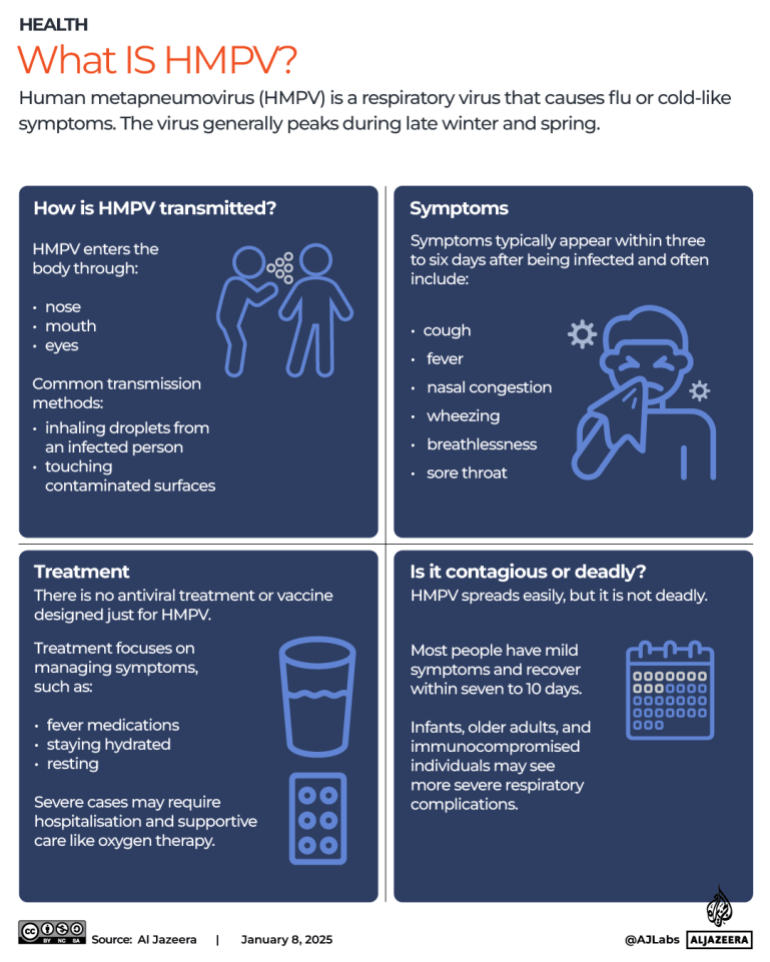What is HMPV, the respiratory virus surging in China?

A flu-like viral disease has surged in China in recent months, particularly infecting children, raising concerns about its potential spread.
In response to the rise in respiratory illnesses during the winter, cases of human metapneumovirus (HMPV) have also been reported from India.
Five years after the Covid-19 pandemic erupted in China, the rise in the cases in early December has raised global health concerns. In recent days, Beijing and the World Health Organization (WHO) have made an effort to calm concerns.
What is known about the virus, which transmits like the flu and COVID-19, as well as other respiratory illnesses.
What is HMPV?
A respiratory virus known as the human metapneumovirus causes flu or symptoms similar to those of a cold.
The virus peaks during late winter and spring, according to the United States-based Centers for Disease Control and Prevention.
First identified in 2001 in the Netherlands, the disease is very common, infecting almost every child by the age of five.
A swab from the nose or throat is used to test HMPV; it is done by prying it from the nose or throat. Similar to COVID, the sample is analysed in a lab, often with RT-PCR tests. Other methods, like antigen tests, can also identify the virus.
How is HMPV transmitted?
HMPV enters the body through the nose, mouth, or eyes, typically after inhaling droplets from an infected person coughing, sneezing, or breathing, or after touching contaminated surfaces.
These transmission methods are comparable to those used to spread the common cold, flu, and other respiratory viruses.
What alters the body does HMPV?
The respiratory tract, which includes the airways and the lungs, is made up of the epithelial cells that the virus enters once it enters the body.
As they clear mucus, dust, and other debris, these epithelial cells act as a protective barrier between the airways.
Once inside the cells, the virus replicates, producing more viral particles. These newly developed viruses infect neighboring cells and spread through the respiratory epithelium.
The body’s immune system recognizes the infection and starts a virus-fighting response. Although necessary to eradicate the virus, this reaction also causes coughing and nasal congestion.

Which nations have seen the most cases of HMPV rise?
In northern China, HMPV cases have been rising among children 14 years and younger, according to Kan Biao, director of China’s Institute for Infectious Diseases.
The increase coincides with the winter months when respiratory infections are more prevalent.
China’s National Disease Control and Prevention Administration announced that it is testing a monitoring system for pneumonia of unknown origin in response to the rising cases.
Since late 2024, HMPV has increased in countries like India and the UK.
India has reported seven confirmed cases of HMPV across several states, including Karnataka, Gujarat, Maharashtra, and Tamil Nadu.
The Indian government has advised states to increase the level of respiratory illness surveillance, as well as to keep up regular hygiene practices, such as washing hands frequently and avoiding close contact with others.
In the UK, between December 23 and 29 last year, some 4.5 percent of lab-tested samples were positive for HMPV, a slight increase from the previous week. In comparison, 29.5 percent were positive for influenza, and 2.5 percent for COVID-19.
Because the virus is not as robust or routine as the flu or COVID-19, precise global data on it is scarce.
Is it contagious or deadly? Who is more at risk?
HMPV is easily spreadable, but healthy people are not typically fatal, according to the WHO on Tuesday.
Because it is not a common name, HMPV was discovered in 2001, according to WHO spokeswoman Margaret Harris in Geneva.
HMPV is “a common virus that circulates in winter and spring”, she said, adding that its case mortality rate is “very, very low”.
Most people go through seven to ten days with only mild symptoms similar to the flu or common cold.
Due to the lack of accurate data and overlap with other respiratory illnesses, accurate mortality rates have been challenging to determine. However, in low-resource settings where access to healthcare is limited, HMPV-linked deaths have been relatively more common.
Additionally, within some people, the virus can lead to more severe respiratory complications, such as bronchitis, inflammation of the airways leading to the lungs, or pneumonia, infection of the lung tissue. This includes high-risk groups such as infants, older adults, and immunocompromised individuals.
Infants, for example, have smaller and more delicate airways, which can become easily inflamed or blocked during respiratory infections. Moreover, their immune systems and bodies are still developing, making it harder to fight the virus.
The immune system is also compromised as a result of aging, and underlying medical conditions make it more difficult to eradicate viruses.
What are the symptoms of HMPV infection?
Within three to six days of infection, these symptoms typically show up:
- Cough
- Fever
- Nasal congestion
- Wheezing
- Breathlessness
- Sore throat
More severe and prolonged symptoms may be felt by vulnerable groups.
How can HMPV infection be treated?
No vaccine or antiviral therapy specifically made for HMPV exists.
Instead, treatment focuses on managing symptoms, such as using fever medications, staying hydrated, and resting.
Source: Aljazeera
Leave a Reply